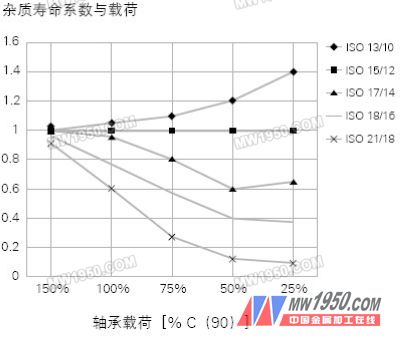Experiments and points for evaluating bearing performance under lubrication conditions with impurity contamination
The second method is to obtain the bearings from the actual use in the field and to describe the size and surface density of the indentations on these bearings by optical mapping for future life analysis. Typically, these bearings are large in size and operate under severely contaminated conditions, and these bearings are not yet fully described in the ISO 4406 specification.
These photographs with indented surfaces are used by engineers to select the level of bearing raceway surface damage that is usually found in their practical applications.
Analysis of a typical life test lubricant performed on a standard life tester showed a basic cleanliness rating of ISO 15/12. For this cleanliness grade, the impurity lifetime factor is 1.0. A cleaner lubricant will provide a longer life, but a lubricant with more impurities will reduce its life.
In order to determine the life reduction factor (life reduction rate), the indentation impurity imprint can be used to analyze the data file in the following manner. The contact loads of the rolling elements for various application states are first determined in order to determine their contact stress and contact area. Then, the effect of the size and number of indentations on bearing life in this environment can be determined. Figure 8 shows a graph of the impurity life factor (a3D) for a tapered roller bearing with a bore diameter of 33 mm, which can be used for different lubricant cleanliness levels, and the radial load is expressed in C% (90) rating. Under heavy load conditions, the effect of the change in impurity level is reduced because the fundamental effect on the overall stress level is reduced when compared to the greater impact of improving the overall stress level under light load conditions.
Figure 2 shows that bearings made of fully hardened steel are more sensitive to impurity indentations than bearings made of carburized steel. Figure 6 shows that the surface carburized bearings are even more resistant to impurities. Figure 9 shows that for moderately polluted environments, bearings made from these materials differ in typical impurity life factors compared to surface carburized bearings. Bearings made of fully hardened steel have a slightly lower life than surface carburized bearings. It is expected that the microstructure of the anti-impurity bearing will be more effective for improving bearing life in a more polluted environment.

Figure 8: Impurity life adjustment VS load and different ISO specifications
Previous page next page
Aluminum foil is made from an aluminum alloy which contains between 92 and 99 percent aluminum. Usually between 0.00017 and 0.0059 inches thick, foil is produced in many widths and strengths for literally hundreds of applications. It is used to manufacture thermal insulation for the construction industry, fin stock for air conditioners, electrical coils for transformers, capacitors for radios and televisions, insulation for storage tanks, decorative products, and containers and packaging. The popularity of aluminum foil for so many applications is due to several major advantages, one of the foremost being that the raw materials necessary for its manufacture are plentiful. Aluminum foil is inexpensive, durable, non-toxic, and greaseproof. In addition, it resists chemical attack and provides excellent electrical and non-magnetic shielding.
Aluminium Foil, Aluminium Foil Tape, Industrial Aluminum Foil
Hongkong NanJie Resources Co.,Ltd , http://www.aluminium-nanjie.com